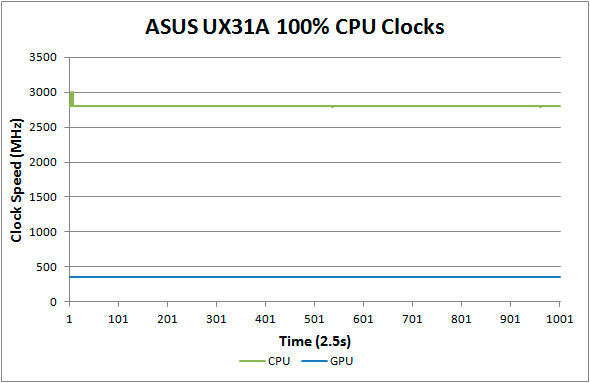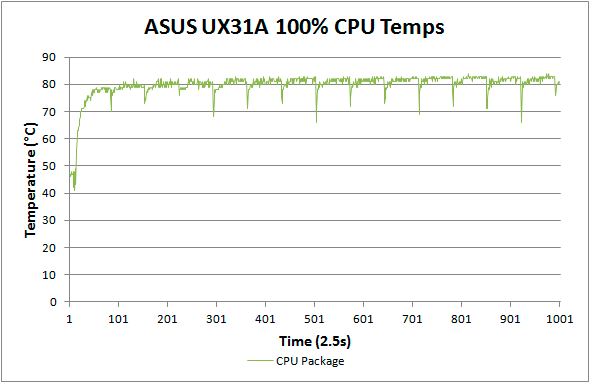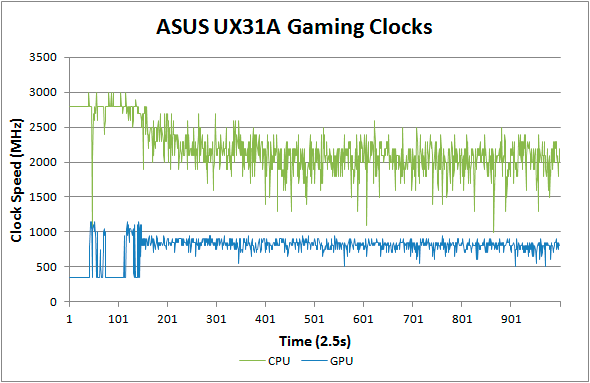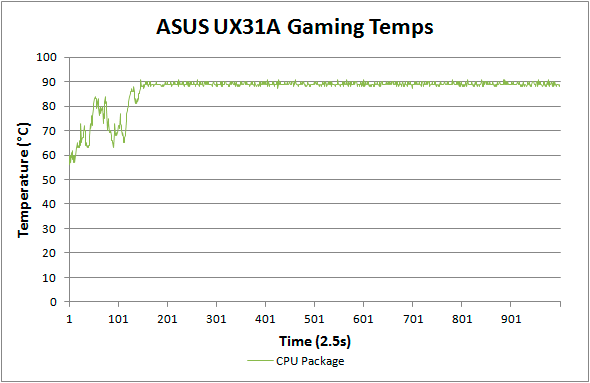ASUS UX31A: Putting the Ultra in Ultrabooks
by Jarred Walton on August 28, 2012 9:00 AM EST- Posted in
- Laptops
- Intel
- Asus
- Ivy Bridge
- Zenbook Prime
- Ultrabook
ASUS UX31A: Stress Testing
For everyday use, most laptops will be fine, and the UX31A is no exception. However, it’s also important to see how a laptop behaves under more strenuous loads—keeping in mind that a brand new laptop has no dust to contend with and is basically performing optimally. Over the life of a laptop, cooling performance will generally deteriorate slightly, and if a laptop already struggles with heat under load (e.g. Dell’s XPS 15), that’s only going to get worse. To see how the UX31A fares, we did some extensive testing for throttling under several sustained loads. First, we stress just the CPU cores by looping the second pass of an x264 encode, all while recording CPU clock speeds and temperatures with HWiNFO64. Then we run a gaming test—in this case Batman: Arkham City—while doing the same, and finally we combine the two and set x264 to use all but one CPU core (so in this case it’s on virtual cores 2 and 3) with Batman running on that core (virtual cores 0 and 1). Here are the clock speed and temperature results for the UX31A.


Loading up just the CPU cores, the UX31A performs admirably. CPU clocks touch 3.0GHz a few times early on, but that’s before we start the x264 encoding loop. For the most part they’re pegged at 2.8GHz and stay there for the duration of our test. There’s a cyclical nature to the temperatures, as every couple of minutes the encoding pass restarts and the brief delay between one loop and the next apparently allows the CPU to recover slightly. While it's not shown in the charts, at the end of the test run temperatures quickly drop back into the “reasonable” range—in under 10 seconds we go from CPU temperatures of over 80C to less than 60C, with another 50 seconds or so (at lower fan speeds) bringing the temperatures down to around 50C, which is where the laptop tends to idle.


Run any 3D game where the GT cores have to work and the story changes dramatically. The CPU cores at 100% load and 2.8GHz consume around 15W of the allowed 17W TDP, but the GT cores under load appear to be capable of drawing 10-11W. Try to use them both at the same time and what follows is a balancing act (i.e. throttling) in order to stay within the allowed power and thermal envelope. The CPU package does manage to exceed the 17W TDP for a time, but after seven or eight minutes it drops to 17W before eventually stabilizing around 15W (±5%). The GPU clocks are also all over the map initially, as in this case Batman is busy loading and we’re watching the intro videos and navigating the menus. After about five minutes we’re in the actual game and we can see the CPU and GPU clocks (mostly) stabilize. Even after more than an hour, however, we still see GPU clocks as low as 500 MHz and as high as 900 MHz, with CPU clocks ranging from 1.0GHz to 2.5GHz—all while we’re sitting still and watching over Arkham City from a high perch. Not surprisingly, the result in terms of actual frame rates is that they can vary upwards of 50%, which makes for a generally less than desirable experience even if average frame rates are 30+ FPS in some titles.


Our final stress test performs x264 encoding while running Batman, with each task set to use one of the two available cores along with the appropriate Hyper-Threaded core. The result isn’t actually all that different from just running Batman alone, with the GPU and CPU cores dropping to lower clocks in order to maintain a package TDP of <17W. Somewhat interesting to note however is that this time the package TDP stays much closer to 17W (instead of 15W), with CPU and GPU clocks tending to be a bit more stable and higher as well. We see the GPU dip as low as 450MHz on occasion, but we also see clocks of 1050MHz on a regular basis; likewise, the CPU drops as low as 1GHz on one core and 1.2GHz on the other core, but much of the time the cores are in the 1.5GHz to 2.1GHz range.
The net takeaway here is that the ULV Ivy Bridge processors can’t actually hit max clocks on both the GPU and CPU cores without exceeding their 17W TDP. There’s potential for configurable TDP to allow plugged-in Ultrabooks to run ULV chips at a higher power envelope to improve performance. In fact, you can set the UX31A to 25W TDP, but it appears the cooling solution isn’t actually able to deal with the higher TDP for longer periods of time and thus the CPU ends up dropping back to 17W after a few minutes of heavy lifting. That’s hardly surprising, considering how thin the UX31A is—there’s just not much space for air to flow through.
More to the point, other Ultrabooks often omit the ability to change the TDP levels, so even with better cooling it wouldn’t be possible to run the CPU and GPU at full tilt; for that, you’d need a 25W TDP in practice—around 10W for the HD 4000 and another 15W for the CPU cores. Dustin tested the HP Envy 14 Spectre, which tended to run quite a bit cooler than the UX31A (and it’s also quite a bit larger). While we didn’t perform a full throttling analysis of the Spectre, we can already see from the above results what would happen. If you’re hoping to run an Ultrabook (i.e. a ULV CPU) at max Turbo Boost speeds all the time while loading up both the CPU and GPU, that just doesn’t look possible. Unless Intel can do something unexpected, I don’t think Haswell will even fix the problem. The simple fact is that loading up all areas of an approximately 1 billion transistor processor die at high clock speeds uses too much power to fit within the ULV TDP, and clock speeds are the way to address the issue.
What about Noise?
With all the stress testing so far, we've focused on CPU/GPU clock speeds and temperatures. System noise is another important factor that we need to look at. There's not as much to discuss, as the fan speed and system noise are very nearly maxed out in all of the above tests (though running just the CPU at 100% may not get the UX31A quite as loud). At idle, the UX31A sits roughly at the limits of our equipment: 30dB. Once we start to put a load on the CPU, fan speed escalates with temperatures until it maxes out at around 80C. At that point, the system fan generates 39.5dB of noise from a distance of one foot. Given we're dealing with a single relatively small fan, it's not too surprising that the character of the noise is slightly less comfortable than other laptops, with a relatively high pitch. I actually found the fan noise to be more annoying when it was in the 35-37dB range, with the pitch seeming to decrease slightly at the maximum 39dB. That said, I doubt most people will be pegging the CPU or GPU that hard with an Ultrabook, which makes the noise less of a concern; for typical Internet and office tasks, the UX31A is usually under 34dB.










106 Comments
View All Comments
nerd1 - Tuesday, August 28, 2012 - link
I'd like to see some quality review of sammy's series 9 laptop. So far I have only seen crappy amateurish reviews so far (*ahem* engadget *ahem* theverge *ahem*) and I think it is one of two best ultrabook options out there with 1600*900 matte PLS display.Toshio - Tuesday, August 28, 2012 - link
notebookreview.com has a decent review:http://www.notebookreview.com/default.asp?newsID=6...
also they reviewed the 15" version, pretty interesting:
http://www.notebookreview.com/default.asp?newsID=6...
an Anandtech review would be pretty good whatsoever ;)
nerd1 - Tuesday, August 28, 2012 - link
That's old gen model with sandby bridge. Engadget review reports 7 hrs of battery life with new laptop - I'd like 'proper' review here. ;]JohnMD1022 - Tuesday, August 28, 2012 - link
PC Decrapifierhttp://pcdecrapifier.com/
ajp_anton - Tuesday, August 28, 2012 - link
"ASUS did provide an updated Realtek driver that seemed to improve the audio quality slightly"Does this mean ASUS has tweaked the drivers themselves, or that it's just a newer version and I don't lose anything by upgrading from Realtek's website myself sometime in the future?
JarredWalton - Tuesday, August 28, 2012 - link
It looks like stock Realtek, but I could be wrong.geniekid - Tuesday, August 28, 2012 - link
Let's not forget the predecessors to these new fancy ultrabooks - the Asus UL series! My laptop at the moment is the Asus UL80Vt and even with its G210M, I can still run TF2, Civ 5, Diablo 3 and Guild Wars 2 on this machine, albeit at low quality and 1366x768 resolution. And this is a 3 year old laptop that cost me $850.These days, I won't be happy without a 650M and 900p resolution on a 14" screen, but the UL80Vt will always have a warm spot in my heart.
falc0ne - Tuesday, August 28, 2012 - link
I really don't see all the fuzz about ASUS.I had quite a few issues with ASUS products, most recent being with a brand new laptop featuring Sandy Bridge platform with core i7 processor that came with the hard drive DOA. I've only seen this happening with Acer or other OEMs that sell 'value' products. But ASUS is charging you premium prices. I just see them charging for premium quality but that quality just isn't there...
From my past experiences I have 2 other desktops that I built and the motherboards failed. One failed in 3 months, the other 9-11 months. I have to mention the laptop the came DOA was in the range of $1600 and the latest motherboard that failed in the $150 price range - so not cheap ones at all.
Anyone else had issues with their products?
Roland00Address - Tuesday, August 28, 2012 - link
Why can't AMD make an ultrathin that is about $500 dollars that uses the a6 or a10 ulvIt would be so easy for AMD to get an OEM to actually build an ultrathin that is cheap and actually good just by swapping out a few parts.
Use a standard 11.6" netbook case. Many oems have cases that can take 17w processors in this form factor that are cheap remember the e series of amd processors have the same tdp as the a6 ulv. The faster celeron and pentium ulv dual cores also use 17w for tdp. For example hm dm1, Sony YB, Sony E11, my favorite the Lenovo Thinkpad x130, Lenovo x131, etc and the Acer Aspire One 756 (they finally got rid of the floating island crap and are now use chicklet). I am going to be talking more about the Acer Aspire One 756 below
Place at least 4 GBs of ram in the computer but it has to be in dual channel mode. If you can't do 2x2GBs then 6 GBs (1x2gb+1x4gb) or 8 GBs. Note all the models I listed above have two memory slots.
At least a 320gb hard drive or a 128 gb ssd. Note all the models I listed above use standard harddrives though some are limited to 7mm high models. The cheapest 320gb 7mm hard drives on the open market cost about $55 to 60, a samsung 830 128gb 7mm height ssd goes for about $100. So lets say $40 dollars extra for ssd.
A 1366x768 screen, it doesn't need to have a high rest just good viewing angles. Currently TN panels are all you can find in the 11.6 form factor, but with the rise of tablets and windows 8 tablets coming out this fall I won't be suprised we will see 11.6 ips screens starting to appear. To put it in comparison a 11.6 inch screen with 768 pixels height in the 16x9 ratio is 10.11" by 5.68" the ipad 2 4x3 ratio with 768 pixels 7.75" by 5.83." Chinese OEMs have complete ips tablets in the 9.7" form factor going for $120 so the screen cost isn't exhorborant if someone is actually making that size and form factor. Problem is no one is currently making this form factor but I hope for windows 8 to change all this.
-------
To put it in comparison. Acer has a Acer Aspire One 756 with a celeron dual core, 4gbs of ram, and 500gb hard drive, with 7 home premium going for $349 final price on the open market. (Full model is AO756-2808-US) It weights 3.04 lbs with its 4 cell battery and is 1.1" inch tall.
AMD has $150 dollars to play with (if they can convince acer to build it) to put the a6 ulv dual core and place an extra stick of memory and suddenly they are in the $500 dollar price market where people will seriously consider buying an amd ultra portable. I know the a6 ulv price that oems pay is nowhere near the difference of a celeron price+$150 since the tray price (which is not neccessary what acer pays intel) of the 3rd generation ultrabook i5 ulv is $225.00. (Intel and AMD don't publish tray prices for their celeron ulv or the a6 4455m)
So why hasn't amd been able to convince anyone to do this? There are only two computer I have seen with the a6 4455m is the 15.6" hp sleekbook. I personally consider this computer fail for it is a 15.6" that weights as much as a 14" and still costs over $600 dollars. Why would someone pay that much, for an item that is so big, yet the have to go with the sacrifices of a ulv processor.
There is also a samsung series 5 13.3" that uses the a6 4455m but its going price is $660 to $700. This computer is more my style but when the 3rd generation i5 version is going for the same price $660 to 700 why the hell would you go with the slower AMD option? (To top it off the Samsung uses the 500gb seagate hybrid drive while the AMD system does not.)
nevertell - Tuesday, August 28, 2012 - link
I'd love to see an article about an ultraportable or atleast a laptop with a 17w i7 dualcore with an express card slot with an external GPU. I know that there is some guerilla hardware involved in these setups and these are the exception, not the rule, but I've always entertained the idea of a portable that doubles as a desktop once you put it in a dock.Ultrabooks by themselves are never going to get further than they are now, since you don't need an i5 to browse the web, but to do anything more, the form factor is sort of limiting the machine. I don't really understand the fuss behind ultrabooks, if intel isn't making it a rule for them to have thunderbolt, as that WOULD solve most of the problems at this point in time I have with ultrabooks. Whilst you wouldn't have a special dock for extra cooling to exceed the thermal limits of the platform, you would at least have a way to connect an external GPU, high speed and high capacity storage and other peripherals.
At this point in time I don't really need a modern ultrabook, I already have one from the 2009- the X200s. It's keyboard is far superior to any of the chiclet keyboards that are trending nowadays, I can easily get 5 hours of usage on my 9 cell battery on wifi (7 and more if I am just writing stuff) and it still is easy to carry around. The only thing I would love to have is a unified high speed interface to connect peripheral devices as the express card slot is too slow. Or, in other words, THUNDERBOLT! Since these ultrabooks have hardware limitations. I can't really do any serious work on them anyway, so why would I need more processing power than I have at the moment from a ultra low voltage Core 2 processor, if it is sufficient enough for the same usage model the ultrabook (as it is now implemented) is intended.
TL/DR version- if there is no thunderbolt, then even a 4 year old ultraportable would suffice to do the ultrabooks job as the form factor and hardware of ultrabooks limit their usage model.